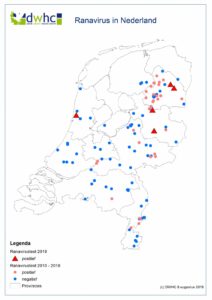Ranavirus found in the province of Drenthe, Overijssel and North Holland
DWHC has now confirmed the presence of the ranavirus at two locations in the province of Drenthe, at two locations in the province of Overijssel and at a location in the province of North-Holland. This is the first identified case of the virus in the province of North Holland. Outbreaks of the ranavirus in the provinces of Drenthe and Overijssel are known to exist, but at three of the four locations it is the first report of ranavirus. These are Boomkroonpad and Ees in Drenthe and the Sallandse Heuvelrug in Overijssel (see map).
Geographical distribution in the Netherlands
The ranavirus was first detected by pathologist Marja Kik of the DWHC in 2010 in frogs in the Dwingelderveld (in the province of Drenthe). The virus was thereafter also found in the province of Overijssel (2011), Noord-Brabant (2013), Gelderland (2013), Friesland (2014), Limburg (2014) and South Holland (2017). And now also in the province of North Holland (2019). The locations are shown on the map below.
Ranavirus
The ranavirus can occur in amphibians, reptiles and fish and can cause many deaths. There are various ranaviruses. The type that has been detected in wild animals in the Netherlands is the Common Midwife Toad Virus (CMTV). Ranavirus has been detected in the Netherlands since the first outbreak in 2010 in nine of the sixteen native amphibian species occurring in the Netherlands. These are all three pelophylax (edible frog, marsh frog and pool frog), the European tree frog, the European common brown frog, common toad, garlic toad, Northern crested newt, and smooth newt. Other countries have shown that the fire salamander, common midwife toad and Alpine newt are also susceptible to CMTV.
Humans
Ranavirus does not cause disease in humans, but can nevertheless easily be spread by humans. People can accidentally infect new areas, because they can spread large concentrations of the virus over large distances via animals, boots, buckets, and landing nets etc. It is therefore important that people take the necessary precautions to prevent the spread of the virus from an infected area to new, non-infected area. Field workers can work with the hygiene protocol that RAVON has formulated.
More information
Further information about the ranavirus can be found at https://www.dwhc-dev.wp.hum.uu.nl/en/diseases/ranavirus/ and https://www.sossalamander.nl/how-can-i-help/report-infected-salamanders/hygiene




